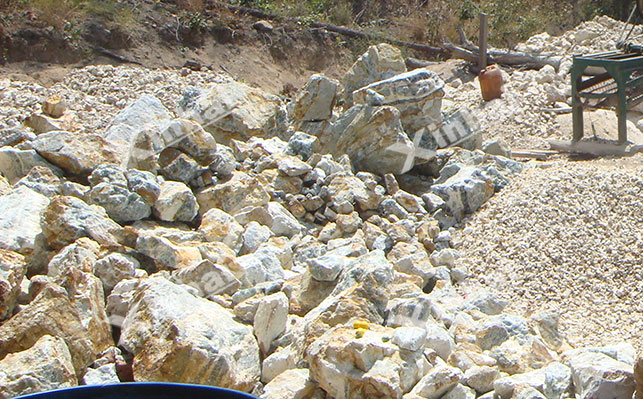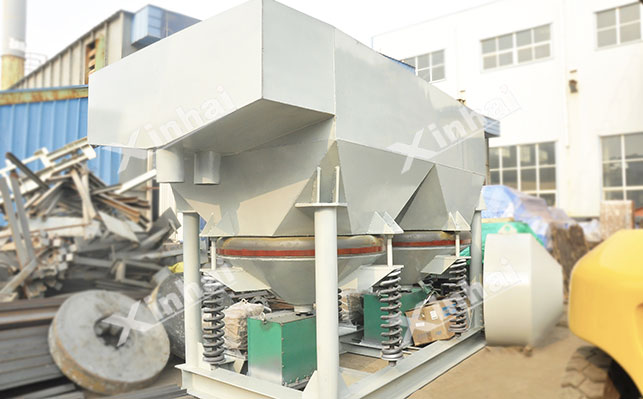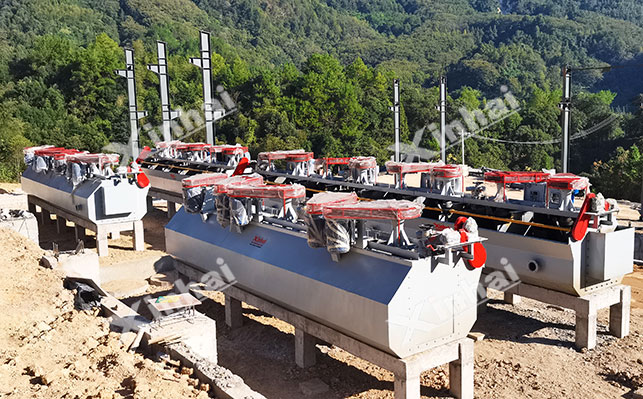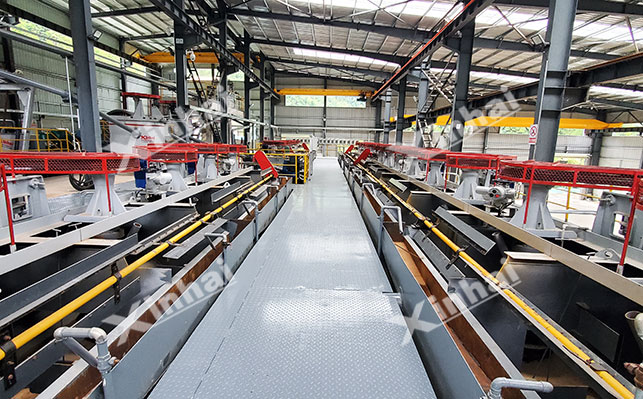
15311826613
Click to add WeChatFluorite, as an important strategic mineral resource, has extensive applications in fields such as metallurgy, chemical engineering, and new energy. With the gradual depletion of high-quality fluorite resources, how to efficiently develop and utilize low-grade lean ore resources is the key. This article will sort out the classification criteria for poor and rich fluorite ores for everyone, as well as the differences in mineralogical characteristics and chemical composition between the two types of ores. It will also summarize fluorite beneficiation methods suitable for both poor and rich fluorite ores in a targeted manner, including gravity separation, flotation, and other advanced techniques to enhance recovery rates.
The classification of fluorite mines is mainly based on the content of calcium fluoride (CaF₂) in the ore. According to the current industry standards in China, fluorite mines can be divided into the following grades based on the CaF₂ grade:

High-grade rich ore: CaF₂ content > 80%. This type of ore can usually be directly used in high-end application fields, such as optical-grade fluorite or semiconductor manufacturing, but its reserves are very scarce, accounting for less than 10% of the total single fluorite deposit in China.
Common rich ore: The CaF₂ content is between 65% and 80%. After simple beneficiation treatment, this type of ore can meet most industrial uses and accounts for approximately 20% of the total single fluorite deposits in China.
Low-grade ore (poor ore) : It is the main source of fluorite in China, with a CaF₂ content ranging from 35% to 65%. Such ores need to go through relatively complex beneficiation processes to meet industrial usage standards.
Ultra-poor ore: CaF₂ content < 35%. This type of ore is difficult to process and costly, and traditional processes are hard to economically and effectively recycle and utilize it.
Rich ores are often dominated by single fluorite ores, with high CaF₂ content, relatively few gangue minerals and simple composition. The main impurities are a small amount of iron-containing minerals and aluminosilicate minerals. For the beneficiation of this type of fluorite ore, the main approach should be "simple purification and retention of high grade", but generally, the principle of "more crushing and less grinding, early polishing and early harvesting" should be followed. Common methods include:
When the fluorite crystals in rich ores are relatively coarse (usually > 5mm), have a clear boundary with gangue (such as quartz and calcite), and the impurities are in block or scattered distribution, large qualified minerals can be selected in advance by hand selection. The process is that after the raw ore is crushed (to 50-100mm), visible gangue minerals are removed through manual picking, and a concentrate with CaF₂≥85% can be directly obtained.

When fluorite in rich ores is coarse-grained and embedded (with a particle size of 5-50mm), and its density difference from gangvein minerals (such as quartz and barite) is significant (fluorite density 3.18g/cm³, quartz 2.65g/cm³, barite 4.3-4.7g/cm³), gravity separation purification can be utilized. After the raw ore is crushed, the particle size range of the ore is controlled within 20-50mm, and the coarse particle gravity separation and enrichment are carried out by using a jigging machine. Fine particle gravity separation and enrichment were carried out using a shaker.
Centrifuge enrichment: Suitable for coarse-grained fluorite ore with a particle size of 20-50mm. Through vertical alternating water flow, the ore particles are stratified. The denser veins such as barite sink to the bottom layer, while fluorite is suspended in the upper layer. A coarse concentrate with a CaF₂ of ≥85% can be directly obtained.
Shaking table enrichment: Suitable for medium-sized ores ranging from 5 to 20mm. The shaker, through the combined effect of inclined water flow and bed surface vibration, enriches fluorite along the fine mining area of the bed surface, while quartz and other gangue stones are discharged along the tail mining area. The separation efficiency can reach 80% to 85%.

Magnetic separation of fluorite-rich ore is mainly used to assist in impurity removal. Since fluorite ore often contains impurities that need to be removed by magnetic separation to improve the purity of fluorite concentrate, permanent magnetic cylinder magnetic separators are often used. When the magnetic field intensity is between 1000 and 1500Gs, magnetic separation is carried out on the crushed ore to adsorb and separate magnetic impurities.
Flotation is based on the surface property differences between fluorite and gangue minerals (mainly quartz and a small amount of calcite). It selectively adsorbs fatty acid collectors on the surface of fluorite, making it hydrophobic and attached to bubbles that float up. At the same time, water glass is used to suppress quartz and other silicate gangue minerals. Finally, through multiple selections to remove residual impurities, high-purity fluorite concentrate is obtained.

Conventional flotation: The process of one coarse and multiple fine is often adopted, using fatty acid collectors such as sodium oleate, water glass to suppress quartz, and sodium carbonate to adjust pH to 8-9, to obtain high-grade fluorite concentrate.
Fluorine-free flotation: Using environmentally friendly collectors such as citric acid, flotation is carried out at pH 3.5-4.0.
The mineral composition of poor ore is complex and diverse. According to the differences in the main gangue minerals, it can be divided into four main types: quartz type, calcite type, barite type and polymetallic co-associated type.
The main minerals of quartz-type fluorite are fluorite (30%-60% CaF₂) and quartz (20%-40% SiO₂). Fluorite and quartz coexist in fine grains, and some quartz encloses fluorite to form a symbiotic body. Flotation is usually adopted. During flotation, it is necessary to enhance the inhibition of quartz to prevent it from entering the concentrate. Sodium carbonate is commonly used as an regulator to adjust the pH of the pulp to 8-9, enhancing the inhibitory effect of sodium silicate on quartz. Oleic acid and tar oil are used as collectors, and sodium silicate as an inhibitor. The coarse concentrate needs to be ground again to break the bond between fluorite and quartz, which can increase the monomer dissociation degree to over 90%.

Calcite type fluorite usually has a relatively high gold content of calcite (15%-30%). Both fluorite and calcite belong to carbonate minerals and have similar surface properties. Conventional flotation methods are difficult to effectively separate them. Therefore, a step-based flotation process for suppressing carbonates is usually adopted, with a two-stage flotation process of alkaline and acidic. This process takes advantage of the easy solubility of calcite under acidic conditions to achieve separation from fluorite.
Alkaline flotation: The pH of the pulp is adjusted to 10-11 by sodium carbonate and sodium hydroxide, and oleic acid and oxidized paraffin soap collectors are added to obtain a mixed coarse concentrate of fluorite and calcite, while suppressing silicates such as quartz.
Acidic flotation: The mixed coarse concentrate is placed in an acidic tank, hydrochloric acid is added to adjust the pH to 4-5, calcite is dissolved to make it lose its floatability, and then fluorite is floated to obtain the concentrate.
This type of fluorite ore mainly contains sulfide ores such as pyrite and galena, with a content ranging from 5% to 15%. Sulfide ores are prone to contaminate fluorite concentrate and need to be removed first to improve the grade of fluorite concentrate. Usually, sulfides are removed by flotation first, followed by fluorite flotation.

Flotation of sulfide ore: Adjust the pH of the pulp to 6-7 with sulfuric acid, add xanthate collectors and No. 2 oil foaming agent, and float the sulfide ore tailings to make the sulfur content ≤0.5%.
Fluorite flotation: The desulfurized pulp enters the fluorite flotation system, where a reagent combination of sodium carbonate, oleic acid and water glass is used for rough selection and fine selection to obtain fluorite concentrate.
Fluorite and barite coexist and have similar densities, with fluorite at 3.18g/cm³ and barite at 4.3-4.7g/cm³. Gravity separation is difficult, so fatty acid collectors are commonly used to adsorb fluorite to achieve their separation. The process is: rough selection - sweep selection - select process.
Rough selection: Adjust the pH of the pulp to 8-9 with sodium carbonate, add a small amount of oleic acid, and prioritize the flotation of fluorite coarse concentrate.
Sweeping: Add excess oleic acid to the rough-selected tailings to float out the barite concentrate.
Selection: Fluorite coarse concentrate uses water glass and tannin to suppress residual barite. After multiple selections, high-purity fluorite concentrate is obtained.
The above is an introduction to the classification standards of poor and rich fluorite ores and the beneficiation methods of different fluorite ores. Whether the material is poor ore or rich ore, the mineral composition, structure, chemical composition and embedded characteristics of fluorite all vary to different degrees. Therefore, the beneficiation method cannot be generalized. It is necessary to conduct targeted beneficiation test analysis on the ore and design a suitable fluorite ore beneficiation plan based on the actual situation to achieve the ideal recovery efficiency.